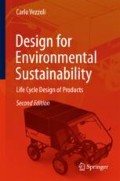Abstract
When speaking about environmental optimisation of a product’s lifetime, two feasible strategies come to mind.
Access this chapter
Tax calculation will be finalised at checkout
Purchases are for personal use only
Notes
- 1.
That is, properly maintained and within the prerequisite limits of mechanical stress.
- 2.
Especially products in a highly innovative sector like infotechnology.
- 3.
Especially products of the fashion industry.
- 4.
For example furniture or bicycles.
- 5.
Actually in some sanitary systems, we can consider replacing water and detergents with mechanical washing components (for example with ultrasound).
- 6.
For example, replacing throwaway packages with reusable ones.
- 7.
For example, a shared computer.
- 8.
These themes are explained later through examples and related guidelines.
- 9.
This topic will be extensively dealt with in Chap. 11 of this part.
- 10.
Cf. afterwards, ‘Facilitating Upgrading and Adaptability’.
- 11.
Computers and their hardware and software.
- 12.
Chap. 10 of this part goes in depth of these topics, as well as of the guidelines and design options.
- 13.
For example, changing oil or replacing the chain, tooth rim or the pinion of a motorbike.
- 14.
Fine-tuning of a car extends its lifetime. Besides, it reduces petrol consumption (lower costs) and emissions of toxic exhaust gases (smaller impact).
- 15.
For further details, cf. Chap. 10 of this part.
- 16.
Landline telephones are exemplary of goods with a low unit cost that almost never are repaired. A new product almost always costs less than any (manual) repair procedure; because of this, almost all damaged goods are replaced immediately.
- 17.
Cf. the ‘Facilitating Maintenance’ and ‘Facilitaiting Repairs’ paragraphs.
- 18.
Cf. Chap. 10 of this part.
- 19.
Besides remanufacturing, the term refurbishment is used; the former refers to more consistent use of industrial operations. In this book, we will not use an extra subdivision, though we see that the real difference is made by using or not using such operations for component modification.
- 20.
For example, plane and bus engines, production equipment and office furniture.
- 21.
For further details, cf. Chap. ‘10’ of this part.
Author information
Authors and Affiliations
Corresponding author
Rights and permissions
Copyright information
© 2018 Springer-Verlag London Ltd., part of Springer Nature
About this chapter
Cite this chapter
Vezzoli, C.A. (2018). Product Lifetime Optimisation. In: Design for Environmental Sustainability. Springer, London. https://doi.org/10.1007/978-1-4471-7364-9_8
Download citation
DOI: https://doi.org/10.1007/978-1-4471-7364-9_8
Published:
Publisher Name: Springer, London
Print ISBN: 978-1-4471-7363-2
Online ISBN: 978-1-4471-7364-9
eBook Packages: EngineeringEngineering (R0)

